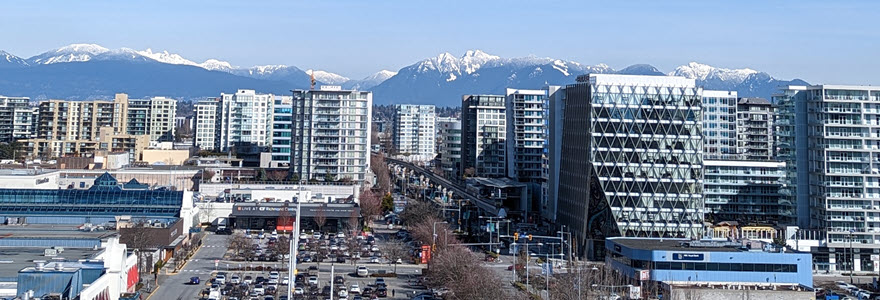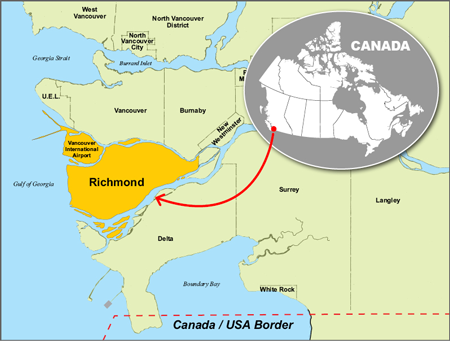City Profile

Richmond is a dynamic and ethnically diverse urban center, blending residential, commercial, agricultural, and industrial spaces. It’s a city where the Fraser River meets the Pacific Ocean, offering an ideal environment for business, nature, and community life.
Richmond strives to be to the most appealing, livable and well-managed community in Canada. Our award winning city has been the recipient of numerous awards for management and innovation. See the latest Annual Report for more information about the City's achievements and financial management.
Location

Located on Canada's Pacific Coast in British Columbia, the City of Richmond is an island city nestled within the Metro Vancouver area. Just minutes from downtown Vancouver and the U.S. border, it offers breathtaking views of the coastal mountain range. The city is spread across Sea Island, most of Lulu Island, and 15 smaller islands, all situated at the mouth of the Fraser River.
| Coordinates: | Latitude 49 10' 59.1" N Longitude 123 8' 0.7" W |
| Elevation: | Averages one metre above sea level |
| Area: | 50.067 square miles 129.666 square km 32,043.477 acres |
View Maps & GIS for detailed geographic information.
Population and Demographics
A vibrant and growing city, Richmond is home to 241,375 residents. Richmond’s population has grown rapidly over the years, particularly with the influx of immigrants, who now represent over 60% of the population. This diversity has fueled a thriving business sector and a rich cultural vibrancy. For more information, visit Population & Demographics.
Key Attractions
- Natural Beauty
The city’s estuary and coastline provide a habitat for diverse wildlife, including birds migrating along the Pacific Flyway. Among the popular sites for experiencing Richmond's unique environmental and cultural heritage are Garry Point Park with its beaches and estuary habitat, Britannia Heritage Shipyard, Gulf of Georgia Cannery and London Heritage Farm. - Gardens and Parks
Richmond offers a wide range of recreational spaces, including parks and the scenic dike trails that offer views of the North Shore Mountains. - Awards and Recognition
Richmond is recognized for its high quality of life, innovation in city management, and urban development. It has received multiple awards for excellence in governance and public service. - Economy and Employment
Richmond’s diverse economy supports over 126,000 jobs, with key sectors including technology & innovation, tourism & retail, transportation & logistics and agriculture & fishing.
Parks, Recreation, Culture & Community
Richmond is known throughout the Vancouver region for its quality Parks, Trails and Cycling Routes, Recreation and Community Centre facilities and its Arts, Culture and Heritage facilities.
- 871 hectares of parkland (2,153 acres)
- 136 km of park trails and 87 km of cycling paths
- Over 140 parks, including sports fields, playgrounds, and nature reserves.
- Richmond also boasts a vibrant arts and culture scene, with libraries, galleries, theaters, and cultural centers that enrich community life.
The system of interconnecting perimeter dike trails offers for a variety of recreational opportunities along with scenic views of the North Shore mountains and natural and historic areas. Cultural facilities include libraries, a performing arts theatre, art gallery, arts centre, museums, archives and heritage sites.
Access & Transportation
Richmond is well-connected to the rest of Metro Vancouver by major bridges, rapid transit, and two railway lines. It’s home to Vancouver International Airport, which offers direct access to international travel.
Climate
Richmond has a temperate west coast climate. Unlike other parts of Canada, the west coast gets little or no snow most winters, and because of Richmond's distance from the mountains, the average rainfall (1,112.6mm or 43.8 in.) is 30 per cent less than neighbouring Vancouver.
Refer to the current weather conditions for the Greater Vancouver Region at Environment Canada's Weather Office for more information.
Winter Games Legacies
During the 2010 Olympic Winter Games (February 2010), Richmond hosted the long track speed skating events at the iconic Richmond Olympic Oval. The city became a cultural and tourism hub, featuring the O Zone celebration site in Minoru Park with live concerts, interactive exhibits, and public skating. Richmond embraced its Olympic host city status through community events, volunteer engagement, and international exposure, leaving a legacy of sport, infrastructure, and civic pride.
Richmond has since transformed a one-time Olympic venue into a lasting community cornerstone—fostering urban growth, environmental design, sport excellence, social vitality, and international recognition.

